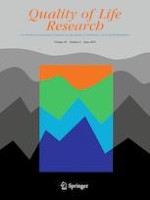21-03-2019
Psychometric properties of the Mandarin Chinese version of the KIDSCREEN-52 health-related quality of life questionnaire in adolescents: a cross-sectional study
Gepubliceerd in: Quality of Life Research | Uitgave 6/2019
Log in om toegang te krijgenAbstract
Purpose
To evaluate the psychometric properties of the Mandarin Chinese version of KIDSCREEN-52 health-related quality of life (HRQOL) questionnaire.
Methods
We conducted a cross-sectional study with two cohorts of school-based data in the urban areas of Weifang, China. 4385 and 841 representative adolescents aged 11–17 years have recruited into the baseline and test–retest group, respectively. Psychometric analyses included feasibility, item and dimension properties, reliability, construct validity, measurement invariance, convergent and discriminant validity, and known-group validity.
Results
The response rates of both baseline and test–retest surveys were more than 90%. Low missing values were found (0.02–1.92%) across ten dimensions. The measurement properties of items were satisfactory. Noteworthy ceiling effects were observed for ten dimensions (6.75–31.84%), while the observed floor effects were negligible (0.02–1.37%). Internal consistency was robust with Cronbach’s alpha (0.819–0.959), while the test–retest reliability was acceptable with the ICCs (0.724–0.849). Confirmatory factor analysis confirmed the ten-dimensional structure and supported the configural and metric invariance across gender and age groups. The Pearson correlation coefficients between the KIDSCREEN-52 and the PedsQL™ 4.0 were stronger in comparable dimensions than those in less comparable dimensions, demonstrating the convergent and discriminant validity. In most dimensions, statistically significant and medium or large effect size differences were found across socioeconomic and mental health status, supporting the known-group validity.
Conclusion
These findings demonstrate that the Mandarin Chinese version of KIDSCREEN-52 seems to work well in a Chinese context, and is a psychometrically valid and reliable HRQOL instrument.
